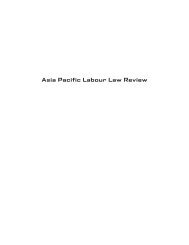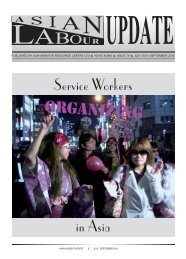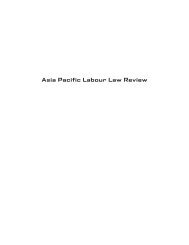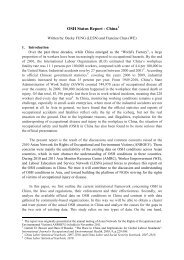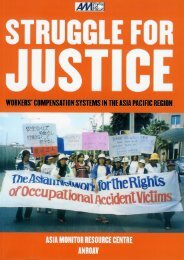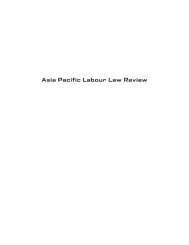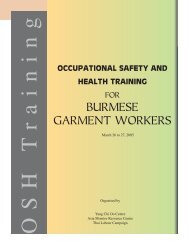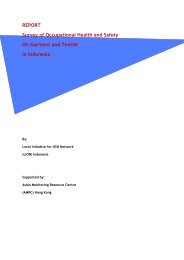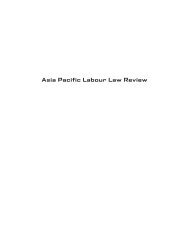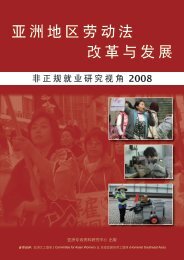Japan - Asia Monitor Resource Center
Japan - Asia Monitor Resource Center
Japan - Asia Monitor Resource Center
You also want an ePaper? Increase the reach of your titles
YUMPU automatically turns print PDFs into web optimized ePapers that Google loves.
<strong>Asia</strong> Pacific Labour Law Review
<strong>Asia</strong> Pacific Labour Law ReviewWorkers’ Rightsfor the New Century<strong>Asia</strong> <strong>Monitor</strong> <strong>Resource</strong> Centre2003
<strong>Asia</strong> <strong>Monitor</strong> <strong>Resource</strong> Centre Ltd.AMRC is an independent non-governmental organisationthat focuses on <strong>Asia</strong>n and Pacific labour concerns.The <strong>Center</strong> provides information, research, publishing, training, labour networkingand related services to trade unions, pro-labour groups, and other development NGOs.AMRC’s main goal is to support democratic and independent labour movements in <strong>Asia</strong> and the Pacific.In order to achieve this goal, AMRC upholds the principlesof workers’ empowerment and gender consciousness, and follows a participatory framework.Published by<strong>Asia</strong> <strong>Monitor</strong> <strong>Resource</strong> Centre Ltd (AMRC), 444 Nathan Road, 8-B, Kowloon, Hong Kong, China SARTel: (852) 2332 1346 Fax: (852) 2385 5319 E-mail: admin@amrc.org.hk URL: www.amrc.org.hkCopyright © <strong>Asia</strong> <strong>Monitor</strong> <strong>Resource</strong> Centre Ltd, 2003ISBN 962-7145-18-1All rights reserved. No part of this publication may be reproduced, stored in a retrieval system, or transmittedin any form without prior written permission.Editorial TeamStephen Frost, Omana George, and Ed ShepherdLayoutTom FentonCover DesignEugene KuoAcknowledgementsAMRC expresses sincere thanks to the following people and organisations for their gratefully receivedcontributions to this book.Suchada Boonchoo (Pun) is co-ordinator for the <strong>Asia</strong>n Network for the Rights of Occupational AccidentVictims. We thank her for all the help in organising our conference of authors in Bangkok.Thanks to the American <strong>Center</strong> for International Labor Solidarity, Bangkok, Thailand for a financial contributiontowards printing the book.We are indebted to Oxfam Hong Kong for their financial contribution towards the production costs.Thanks to the International Labour Organisation for allowing us to use photographs from their library freeof charge.Eugene Kuo, a freelance photographer and designer, a big thank you for contributing photographs and designingthe cover free of charge. Look at www.226-design.com for some of Eugene’s stunning work andideas.To Tom Fenton, co-founder (with Mary Heffron) of AMRC – thanks a lot for advice, maps, and all the timedevoted to the layout of the book, free of charge. E-mail: tfenton@igc.org.Finally, we would like to thank the International Centre for Human Rights and Democratic Development,Canada, for an extremely generous contribution that covered much of the publishing costs of this book.Without their last-minute financial assistance, it is possible that this book would never have proceeded beyondthe editing stage. E-mail: ichrdd@ichrdd.ca; URL: www.ichrdd.ca.<strong>Asia</strong> <strong>Monitor</strong> <strong>Resource</strong> Centre
Labour Law in <strong>Japan</strong> in the Eraof Neo-liberal ReformsHirokuni TabataContemporary snapshotNew legislation on dismissal has become one of the most important issues of labour law reform in <strong>Japan</strong>. A policydocument of the government in June 2001 identified it as a pillar of labour policy, which itself is a part of an encompassingeconomic policy of the Koizumi Cabinet.The <strong>Japan</strong>ese economy has experienced an economic recession since the beginning of the 1990s. Employmentin the industrial sector has contracted constantly and the overall unemployment rate has reached five percent,which is the highest after World War II. During this period, employment security has degraded conspicuously.The ratio of part-time workers and temporary workers in the active population has grown rapidly. The myth of‘life-time employment’ has been exposed and many workers feel insecurity in employment. ‘Karoshi’ (deathfrom overwork), a famous symptom of <strong>Japan</strong>ese employment relations, has ceded its place to a new phenomena1
East <strong>Asia</strong>‘Risutora Jisatsu’ (suicides from restructuring of firms)in the public opinion.The proposed new legislation intends to mitigate legalrestraints on dismissal. Law on dismissal in <strong>Japan</strong> isessentially an evolution of case law in the courts. <strong>Japan</strong>esecourts have ruled that the employer cannot arbitrarilydismiss employees and that a socially rationalcause is required for legitimate dismissal, while the LabourStandards Law demands only 30 days notice orpayment in lieu of this period. Case law has restrainedemployers’ power so far. Particularly, the courts demandfour conditions for collective redundancies to be legitimate(see later discussion).Discussion on the new legislation began in businesscircles. The theory of neo-liberal economists justified it:rigidity of labour markets impedes job creation whereasflexibility enhances the rate of employment. The governmentis to set up a ‘reasonable’ procedural frameworkmaking redundancies easier. Trade unions opposethis idea, demanding on the contrary more protectivelegislation on dismissal because case law is, generallyspeaking, more fragile than statutory rules.<strong>Japan</strong>ese labour law has experienced many reformssince the mid-1980s.A new law on temporary work businesses was enactedin 1985, legally permitting temporary businessesthat were prohibited by the Employment Stability(placement) Law of 1947. Also in 1985, legislation onwomen’s employment welfare was revised and becamevirtually a new law on equal opportunity in employmentbetween men and women (the Equal Employment OpportunityLaw). The Labour Standards Law’s section onworking hours was revised in 1986 to introduce astep-by-step reduction in working hours and at the sametime flexible measures on working time.In 1997, the Equal Employment Opportunity Lawwas fundamentally modified and strengthened, but at thesame time protective measures for women in the LabourStandards Law were abolished. A law on parental leavewas enacted in 1991 and it was extended to the Parentaland Family Care Leave Law in 1995. As to the measurefor flexibilisation of the labour market, the TemporaryWork Law was revised many times (1990, 1994, 1996)and the 1999 amendment led to a general permission oftemporary businesses in different occupations. And thestipulations on flexible working hours, including thepresumed hours scheme or discretionary work scheme(certain hours are presumed to be worked irrespective ofthe actual hours for certain categories of employees) wereextended in its scope of application by the 1998 amendmentof the Labour Standards Law. Lastly, private placementservices were liberalised in 1999 by the amendmentof the Employment Security (placement) Law.Labour law reforms in favour of flexibilisation of thelabour market have been a dominant feature of the governmentlabour policy of the decade. The last bastion oflabour law concerns the restriction of dismissals. The labourlaw system as a whole is being weakened andflexibilised through legal reforms.Trade unionsTrade union centresRengo (<strong>Japan</strong>ese Trade Union Confederation):the largest union umbrella organisation with over 70 industrialfederations and around eight million members.Zenroren (National Confederation of Trade Unions):the second largest national organisation that hasabout 25 industrial federations and around 860,000members.Zenrokyo (National Trade Union Council): leftistex-Sohyo faction with about 40 affiliates and 280,000members.Major new union formationMost unions affiliated to the labour centres above areenterprise-based unions, but new types of unions haveemerged since the 1980s, still small in size and weak financially,but attract much more public concern thantheir mere size suggests. There are various types of newunions: community unions organised locally; managers’unions for professionals; and women’s unions. Theseunions are generally organised outside the companiesand therefore their organising practices and union behaviourare different from those of traditional <strong>Japan</strong>eseenterprise unions.Major labour legislationWorkers’ welfareLabour Standards Law 1947: stipulates the minimumstandards of working hours, paid leave, work rules2<strong>Asia</strong> <strong>Monitor</strong> <strong>Resource</strong> Centre
JAPANand other regulations in the contract of employment.Normal working hours are now 40 hours a week, eighthours a day.Minimum Wage Law 1959 (separated from the LabourStandards Law)Law on Securing Wage Payment 1976: deals withthe procedure of wage payment in case of bankruptcy.Collective labour rightsThe 1946 <strong>Japan</strong>ese Constitution declares workers’fundamental rights to organise, to negotiate collectively,and to go to strike (Article 28); the Trade Union Law1946 and 1949 defines collective labour rights moreprecisely.Trade union rightsTrade Union Law 1949: every worker has a right toorganise and to affiliate to a trade union freely withoutinterference by the employer. The trade union has a rightto collective bargaining under the auspices of the unfairlabour practices scheme of the same law. The right tostrike is guaranteed by immunity from civil and penalsanctions for legitimate strikes. The trade union canmake a legally enforceable collective agreement withthe employer.Occupational health and safetyOccupational Health and Safety Law 1972 (separatedfrom the Labour Standards Law): is a comprehensivelaw on occupational health and safety including asystem to regulate dangerous equipment, harmful materials,and the system of workplace controlled throughthe committee on health and safety etc.Gender-related legislationEqual Employment Opportunity Law (virtually newlegislation in 1985, revised in 1997): prohibits discriminatingpractices in recruitment, assignment, promotion,training, corporate welfare, retirement, and dismissal.However, the sanction against violation is only to publicisethe name of offenders. On the other hand, case lawhas played an important role in gender equality. The <strong>Japan</strong>esecourts have fairly strictly applied the anti-discriminationprinciple Article 14 of the Constitution andSections 3 and 4 of the Labour Standards Law covering‘public order’, which regulates private contractual relationships.More recently, the Basic Law for Gender FreeSociety 1999, a programmatic law, was enacted to promotegender equality in society as a whole.Employment discriminationThe Labour Standards Law has a general principlefor equal treatment of workers in employment relations.Section 3 of the Law states ‘The employer cannot treathis/her employees discriminatorily concerning wages,working hours, and other working conditions because ofnationality, [political and religious] belief, or social status’.There is no specific independent legislation on discriminationin general, but discriminatory practicesare considered illegal under this stipulation.Strike against Kansai University which has violated the labour laws for decades.(Credit:Neo Yamashita, Education Workers and Amalgamated Union Osaka)Unfair dismissalIn law, the term ‘unfair dismissal’ covers two kindsof illegal dismissal. One is dismissal for union activities,which is prohibited as an unfair labour practiceby the Trade Union Law. The other is more general,and concerns dismissal without just cause. This essayfocuses on the latter.Civil law provides quite liberal rules concerningdismissal. A worker on a contract of employmentwithout a specified term can be dismissed at anytime with two weeks’ notice without any reason. Aworker employed on a fixed-term contract is dismissedautomatically by the expiry of the contractterm. This modified by the Labour Standards Law,<strong>Asia</strong> Pacific Labour Law Review3
East <strong>Asia</strong>which requires the employer to give 30 days’ notice or topay the 30 days’ wages in lieu of notice (Section 20). 30days notice is required to dismiss employees on indefinite-termcontracts and employees on fixed-term contractswhose term exceeds two months. This protectiondoes not apply to workers employed on daily contracts,fixed-term contracts shorter than two months, or seasonalcontracts shorter than four months (Section 21).The Labour Standards Law provides protective measuresfor dismissal. Employees cannot be dismissed duringa period of absence due to occupational accident ordisease and 30 days after that absence. Women cannot bedismissed during maternity leave and the 30 daysthereafter.The following reasons for dismissal are prohibited bythe law: worker’s nationality; political or religious belief;social status (Labour Standards Law Section 3);declaration to the Labour Inspection (Section 104 para2); gender (Equal Employment Opportunity Law Section8 para 1); declaration to the Equal OpportunityCommission (EEOL Sections 12 and 13); parental orcare leave (Parental and Family Care Leave Law Sections10 and 16); declaration of illegal practices concerningtemporary work (Temporary Work Law Section49-3 para 2); affiliation to a union; and union activity(Trade Union Law Section 7).Thus the employer can dismiss workers in accordancewith such procedure. However, dismissals aremore difficult in practice. According to the case law ofthe <strong>Japan</strong>ese courts, the employer has to prove a sociallyacceptable reason of dismissal. Courts regard a dismissalwithout such reason as ‘abuse of the right to dismissal’by the employer and such dismissal is null andvoid. Of course, it is not always easy for workers toprove that abuse has occurred, but <strong>Japan</strong>ese workershave enjoyed a fairly strong guarantee of employmentunder case law.Individual dismissalAbsenteeism or violation of work rules are sociallyacceptable causes of dismissal. Dismissal is generallyassumed to be legitimate when a worker cannot or doesnot work appropriately, and when a worker violatescompany rules. However there are various contentiouscases and the courts have not been impartial in manycases. For example, a worker who refused to work overtimefor personal reasons was dismissed on the groundsof disobedience to the superior’s order, which itself wasa reason for disciplinary dismissal in company rules. Inthis case, the Supreme Court ruled that the dismissal waslegitimate. Refusal to work one hour of overtime wasconsidered a just cause for termination of life-long employmentin this case; the actual reason for this dismissalwas the worker’s political belief. In another case, an employeehad been ordered a transfer to a site which wasvery far from the plant he worked for. The employee refusedthe transfer because of his family situation, especiallyto care for his mother. The company dismissedhim and the court approved the company’s decision.Collective dismissal or redundancyThe courts have identified four preconditions necessaryfor redundancies to be legitimate:• economic necessity;• no alternative measures to respond to the financialdifficulties;• reasonable criteria for the selection of employeesto be dismissed; and• prior consultation with union or employee representatives.While those conditions are the result of case law, theyare fairly effective in restraining arbitrary redundancies.This has led to recent criticism of case law from the employers’organisations, and some recent court decisionsnow ignore this traditional rule.Dismissal of atypical workersThis is the most contentious issue regarding dismissal.Most part-time workers are employed underfixed-term contracts, usually for two or three monthterms. A considerable number of workers are onfixed-term contract. When these workers are dismissed,employers indicate the expiry of the contracted term, assertingthat the employment relationship ended not dueto dismissal but to the expiry of the term, even if the contracthas been renewed many times previously. The solutionof this case law is that the employer cannot end thecontract only by reason of the expiry of the term whenthe contract has been renewed several times and/or thereis a situation where a worker can reasonably expect contractrenewal. In such cases, the court examines the reasonof dismissal like other normal dismissal cases.4<strong>Asia</strong> <strong>Monitor</strong> <strong>Resource</strong> Centre
JAPANIndividual and collective dismissals are restricted bylegislation and case law to some extent. Employment securityis fairly well guaranteed legally as so-called lifetimeemployment has been regarded as an importantfeature of <strong>Japan</strong>ese employment practice. However,there are shortcomings in present laws.First, there is no explicit legal stipulation in currentlegislation except a very simple procedural requirementand a general principle of limitation of dismissal. Almostall things are left to case law even though <strong>Japan</strong> generallyhas no tradition of case law like Britain or the USA, socourt decisions are generally unstable and unpredictable.Second, there is no specialised tribunal for labourmatters. All cases are filed at ordinary courts and hencethe lawsuit uses considerable costs and takes a longtime. Absence of a labour tribunal or labour court discouragesworkers from taking action even if it is necessaryfor them. Therefore, legal protection ofemployment is virtually ineffective in practice.Third, many people believe that fixed-term contractscan easily be dissolved upon expiry of the term, despitethe opposite interpretation by the case law judgement.Part-time and temporary employment is very unstable.The proportion of such atypical workers is about onequarter of the total workforce. Moreover, many workersof small and medium firms do not enjoy an employmentsecurity.Developments of labour lawCollective labour law<strong>Japan</strong>ese labour law has undergone continuous changessince the mid-1980s, whereas it had experienced onlymarginal changes during the high economic growth eraof the mid fifties to seventies.Before the 1980s, the basic framework of <strong>Japan</strong>eselabour law was constructed on three major laws: TradeUnion Law 1945 and 1949; Labour Relations AdjustmentLaw 1946; and Labour Standards Law 1947.Those laws are the product of democratic reform in thepost-war era, the basic idea being to establish an equalpartnership between labour and management, and goodworking conditions through collective bargaining andlegal regulation of minimum labour standards. The fundamentalrights of workers were written into the 1946Constitution.During the period of high economic growth, collectivebargaining was important in determining wage levelsand other working conditions, although the enterpriselevel labour-management relations continued tobe crucial. The legal system worked fairly well due tothe fairly strong bargaining power of unions. Nationalunions divided into three camps – the leftist organisationSohyo was most influential while rightist Domeiand moderate Churitsu Roren were runners-up. Severalindustrial organisations of unions like the Steel IndustrialFederation, the Coal Industrial Federation, the NationalRailway Union, the Private Railways Federationbacked Sohyo, while the Textile Industrial Federationof Domei and the Electric Industrial Federation ofChuritsu Roren were powerful and obtained de factocollective bargaining at industry level whereas formalcollective agreements were concluded at enterpriselevel. The idea of labour law promoting the collectivedetermination of wages and conditions was fairly wellimplemented.The philosophy of post war labour law was based onthe equal bargaining positions of workers and employers.The labour movement of this period respondedwell to it. The status of interim or contingent workerswas improved and they were often incorporated as regularworkers under union pressure.However union bargaining power weakened remarkablyafter the 1980s. Union density declined steadily andthe number of strikes decreased rapidly. Meanwhilemanagement power strengthened because of rising unemploymentrates and the increasing influence ofneo-liberal competition-oriented ideology. Downsizing,restructuring, and redundancies became common inmany sectors. To downsize, companies adopted variouspolicies such as reducing the number of regular employees,increasing part-time or temporary employment, relyingon subcontracting workforce, and so on. Besides,individualised human resource management techniquessuch as the appraisal system for pay and promotion intensifiedcompetition between workers.The situation did not correspond to legal principlesand philosophy of labour law, but factual transformationof the power balance between labour and managementnow appeared to transcend the rule of law. In otherwords, even if the legal scheme itself was intact, the ideaof labour law became obsolete in practice.<strong>Asia</strong> Pacific Labour Law Review5
JAPANsive new legislation and through changes in personnelmanagement policy of the firm. Restructuring of thebusiness organisation accompanied with redundanciesand transfers of workers is regarded by managers notonly an unavoidable measure but also favourable one forits competitiveness in the market. The so- called ‘<strong>Japan</strong>eseemployment practices’ are at present criticised asinefficient and even as a cause of stagnant or grudgingbehaviour of the <strong>Japan</strong>ese economy. Hiraiwa Commissionof the government (Study Group on Economic Reformheaded by Mr. Hiraiwa Gaishi) weighted in favourof business leaders in its composition published its reportin 1993, which proposed massive deregulation ofsocial and economic institutions. Recommendation of1995 by the Administrative Reform Commission underlinedthe necessity of deregulation of labour laws includingthe liberalisation of temporary work businesses.‘Deregulation’ and ‘structural reform’ became henceforthkey words of economic and social policy of thegovernment. A report of 1998 published by the EconomicCouncil of the Economic Planning Agency arguedthat the <strong>Japan</strong>ese economic system based on thecoordination between different economic actors had tobe reformed. Here the notion of the economic coordinationincluded the long-term employment practice andthe seniority wage system in the field of labour. Asstated by Nikkeiren (<strong>Japan</strong> Federation of Employers Associations)in 1995, the three types of employment wereconsidered in this document as main pillars of a future<strong>Japan</strong>ese employment system: core workforce with employmentsecurity, fluid workforce with special skills,and flexible workforce of different occupations. Theconcept that a regular permanent employment with jobsecurity should be a rule was abandoned through thesepolicy papers of the government and of the employersassociations.The transformation of the basic concept on employmenthas promoted deregulation and liberalisation of labourlaws relating to the labour market in the latter halfof the 1990s, in particular. The Temporary Work Lawenacted in 1985 has been successively revised in 1990,1994, 1996, and 1999. Temporary work business initiallyprohibited by the Employment Stability (Placement)Law of 1947 was partially legalised by the 1985law for specific skilled jobs and became liberalised bythe 1999 Law for all jobs except some categories of jobs.Legal restriction of the fixed-term contract was eased bythe 1998 revision of the Labour Standards Law. Whereasthe LSL had permitted the fixed-term contract onlywithin one year and the contract over that period was regardedas permanent employment, the 1998 reform extendedit up to three years for specialists in research anddevelopment, specialists in firm’s restructuring, andaged people older than sixty years. Government policypanels assert yet more flexibility such as three years orfive years term for every occupation. It is evident thatlonger fixed-term contract and its generalisation wouldmake it easier to replace permanent regular workers withfixed-term workers. Reformers are aiming at a morefluid labour market, which is believed to be more efficientand they asserted that a fluid labour market needsbetter function of placement agencies. The amendmentof the Employment Stability (Placement) Law in 1999inaugurated a new era of job placement: private placementbusinesses are permitted to run freely in principle,under the condition of administrative regulation. However,business circles are demanding further liberalisationwhich would allow the agency to collect the fee from jobseekers.Restructuring of businessesand employment securityUnder the pressure of long economic recession, the restructuringof business became a fashion of businessmanagement. The Division of Undertakings and theContract of Employment Law of 2000 defined the rulesfor contractual relationships between the divided companyand its employees. According to the law, the employeesworking at the sections transferred to a newcompany will be transferred to the new company andthose working at the remaining sections will be employedcontinuously by the company. The scheme oflaw seems to guarantee the employment, however thelaw does not aim at the protection of employees itself butto promote restructuring of business by easing the conflictthat might be caused.The employment relationship in <strong>Japan</strong> has been regarded‘stable’ as the well-known term of ‘lifetime employment’suggests, but the reality of employment ismore unstable and vulnerable for workers. Collective redundanciesare legally controlled only by the case law asmentioned above and there are many ways that the com-<strong>Asia</strong> Pacific Labour Law Review 7
East <strong>Asia</strong>pany could evade the legal and practical restrictions ofredundancies. One is subcontracting arrangements thatenable redundancies through a cut of business contract.A parent company can easily manipulate its subcontractingfirms in terms of labour costs and union activities,while it is usually difficult to prove its legal responsibilityas an employer.Division of undertakings can be a sophisticated wayof redundancies. If a company has a department or a sectionwhose business performance is not so good, it can‘divide’ itself and separate its bad section into the newcompany. A newly created company will be an independentbusiness with bad financial situation, while theprincipal firm will be liberated from business risks. Thenew company will presumably cutback its business andreduce personnel after a while. This time, the redundancieswill be easily justified by the bad situation ofbusiness. The law of 2000 is supposed to function likethis.Flexibilisation of working timeFlexibility of working time is another major tool for ‘numericalflexibility’. The <strong>Japan</strong>ese labour law introducedfor the first time in 1987 a modification of standardworking time practices. The standard working timemeans here a fixed working time from 8 o’clock in themorning to 5 in the evening for example. Three types offlexibilisation were introduced at the time, that isso-called ‘flex-time’, ‘variable working hours’, and ‘discretionarywork scheme’.The ‘flex-time’ system will not need so much explanation.Under this system workers can determine theirtime allocation of a week except the ‘core time’ definedas necessary attendance. The second measure of ‘variableworking hours’ can be implemented through anagreement between management and a union organisingthe majority of employees or when it does not exist arepresentative of employees. According to this schemerevised in 1998, working hours can vary by day up to 10hours and by week up to 52 hours under the conditionthat the averaged total working hours within a perioddoes not exceed the statutory minimum standard of 40hours a week. This system makes possible for the employerto reduce a slack of working hours and enhancethe intensity of work.The last measure of ‘discretionary work scheme’ isvery peculiar to the <strong>Japan</strong>ese labour law reform. Thissystem intends to virtually dislocate the statutory regulationof working hours for white-collar employees and researchers.Reformers maintained that the traditionalregulations had been designed for blue-collar workersworking at the plant and that white-collar workersshould have more flexible working hours. According tothis scheme, highly qualified employees in research anddevelopment and in managerial planning are supposedto have worked certain hours, 40 hours a week for example,irrespective of their actual working hours. The reasonof such assumption is that the way to perform the joband the time allocation of those workers are largely leftto their ‘discretion’ (Articles 38-3 and 38-4 of the LabourStandards Law). To implement this scheme, theemployer has to get a consent of the employee representativeor the union that represent the majority of employeesregarding the older scheme for the jobs that anordinance of the Ministry decides, or a consent of a committeecomposed of an employer and employee representativesregarding the newer scheme for the jobs ofmanagerial planning and research. For the latter case,the individual consent of a concerned employee is required,too. The legal scheme as a whole is very complicatedbecause of the resistance of trade unions in theprocess of legislation.Finally, we have to touch upon the regulation of overtimework. The Labour Standards Law has a fairly restrictiveprovision about overtime work. That is,overtime work is permissible only when an employerhas reached an agreement with the employee representativeor union that represent the majority of employees,and the employer who ordered overtime work withoutan agreement is to be punished by Law. However, mostunions and employee representatives are ready to giveconsent easily and the amount of overtime hours in <strong>Japan</strong>is large. In addition, there are widespread practicesof ‘service’ overtime without pay, so that the actualovertime hours far exceed the official data. Although unionsand academics are claiming a legal disposition thatputs a ceiling for maximum overtime hours, the governmentdoes not accept such a proposal. This is a focalpoint of discussion of the labour side concerning labourlaw reform in terms of working hours.8<strong>Asia</strong> <strong>Monitor</strong> <strong>Resource</strong> Centre
JAPANPolitics of labour law reformAs I noted earlier, current labour law reform has beencarried out by the initiative of business circles and statebureaucrats as a part of the encompassing deregulationpolicy.Generally speaking, ministerial bureaucracies play adominant role in legislation in <strong>Japan</strong>, not the parliamentarymembers. The orthodox procedures of labour legislationwere like this. At first, an advisory commissionfor the Minister of Labour specialised in a specific matterexamines legal measures to resolve a problem andthen the Minister proposes some necessary measures toa statutory tri-partite council for its examination and afterthe report of that council the Ministry makes a draftof a bill. And the bill will be submitted to the Diet by thegovernment. In this procedure, the tri-partite councilssuch as the Central Labour Standards Council or theCentral Employment Security Council have a considerablyimportant role, because if the labour members opposeit to the end the final report of the council becomesimpossible in practice.Compared to this orthodox procedure, recent legislativeprocess has two distinctive characteristics. First, alegislative initiative shifts to the top-level policy makingorgans such as the Administrative Reform Committee.The basic orientation of critical issues such as temporarybusinesses or ‘discretionary work scheme’ has been decidedat this Committee. Second, the effective role of thetri-partite councils has been reduced proportionately. Atthe time of the amendment of the Labour Standards Lawin 1998, the Ministry made a decision at the Central LabourStandards Law Council without a consensus in theCouncil. Labour opposed the extension of ‘discretionarywork scheme’ and employer side claimed a generous applicationof this system at the Council, but the Ministrymade its own position at the midway. A similar situationoccurred when the Temporary Work Law was revised in1999.This means that the policy and law making process in<strong>Japan</strong> has changed in very recent years. A kind of consensuspolitics has been broken down and the voice ofthe labour side has been ignored by the state bureaucrats.This means again that the recent law reforms includemeasures that are against the labour’s interests and thatthe pressure of neo-liberalism or of the business side isso strong. However, labour resisted in the Diet throughOpposition parties, resulting in a complicated legal systemof ‘discretionary work scheme’ as mentioned above.During these reform processes, some cooperation betweendifferent streams of labour movement, Rengo,Zenroren and Zenrokyo has materialised.Final remarksLabour law is originally a legal measure of protectionfor workers in the labour market. If workers have sufficientindependence and bargaining power in the market,we do not need it. Civil law will be sufficient for the legalcoordination of the labour market.The essential assertion of neo-liberal argument consistsin a denial of the specific nature of workers’ positionin the market and in the firm. They argue that a freemarket transaction without any constraint is most efficientand therefore most beneficial for the parties. Accordingto this argument, labour law will lose its reasonfor being. It may be unbelievable, but law reformers inrecent years really have a thought of such kind. The recentlabour law reform is, in consequence, going to dismantlethe edifice of labour law as a whole. Actuallegislation is, of course, made with many considerationsand as a product of power relations in politics and industrialrelations, but the essential orientation and the basicidea of recent legislation are in line with this argument.When the extension of the legal upper-limit of the periodof fixed-term contract from one year to three yearsfor certain workers was discussed, there were no theoreticalbasis for the limit of three years, nor for the categorizationof concerned workers. Those conditions definedby law amendment were simply a result of compromise.Some policy makers including business circles claimedfive years and general application to all jobs. Five yearsin this case is borrowed from a provision of the CivilLaw that has no theoretical basis by itself. After all, theywant to remove the legal restriction for fixed-term contracts,because they think that fixed-term contractsshould be concluded freely according to the principle ofthe freedom of contract, which is an expression of theidea of free market on the level of law.The case of the expansion of the ‘discretionary workscheme’ is the same. The complicated legal system wasa product of compromise at the Diet and the true aim ofthe reformers consists in a total liberalization of white-<strong>Asia</strong> Pacific Labour Law Review9
East <strong>Asia</strong>collar workers from legal regulation. They often talkabout a ‘white-collar exemption’ concerning workinghours regulation. That is, no regulation for white-collarworkers in terms of working hours.On the other hand, the concept of ‘equal opportunity’is widely accepted by neo-liberal bureaucrats. When theEqual Employment Opportunity Law was revised andstrengthened in 1997, protective provisions for womenworkers were removed as being contrary to the equalitybetween men and women. The tendency towards ‘equalopportunity’ coincides, of course, with the logic of thefree market where all actors are assumed as free andequal on the market. The most crucial point derivedfrom that logic is to reward workers in proportion totheir merit or ability. This idea of ability-based pay becomesmore and more popular in recent <strong>Japan</strong>ese businesses.Nevertheless, structural pay differentialsbetween male and female workers and full-time regularworkers and female dominated part-time workers remainlarge and no effective measure has been taken bythe government so far.All those things suggest that <strong>Japan</strong>ese workers havebeen more and more exposed to crude market forceswithout legal protection. Rengo and other labour organisationsare unanimously criticising the current neo-liberallaw reforms, however the power of the labourremains still weak and a new development of the labourmovement is expected.10<strong>Asia</strong> <strong>Monitor</strong> <strong>Resource</strong> Centre




